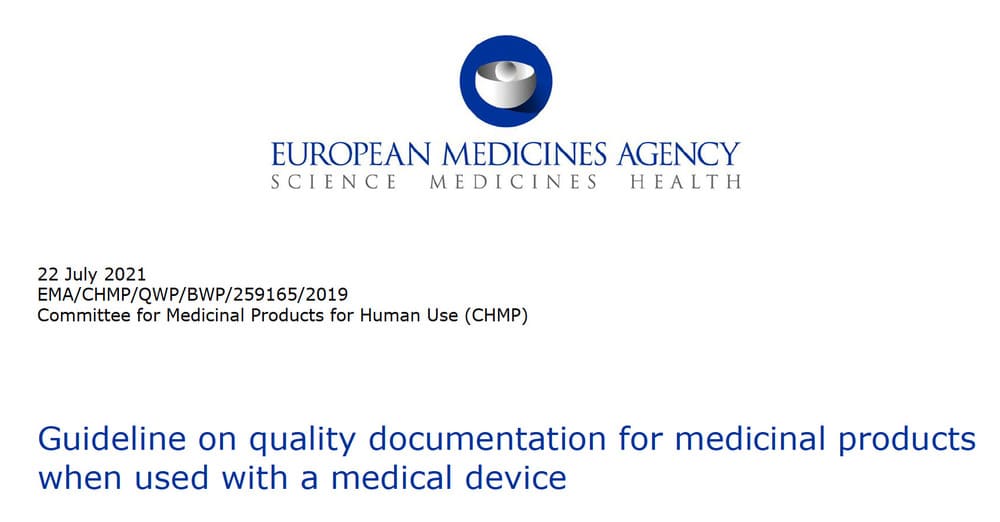
Medicinal products used with a medical device: what does the EMA guideline on quality documentation have to say?
News
1. When the worlds of medicines and medical devices meet
Since the entry into force of Regulation (EU) 2017/745 (MDR), the boundary between medicinal products and medical devices has become considerably more complex. One of the hotspots: combi-products, or combined products, where a medicine is used with a medical device - whether integrated, co-packaged or referenced.
In response to this growing complexity, the EMA has published a specific guideline:
Guideline on quality documentation for medicinal products when used with a medical device (EMA/CHMP/QWP/BWP/259165/2019), in force since January 1, 2022.
It specifies expectations in terms of quality documentation in the MA (or post-MA) dossier for a medicinal product associated with a medical device. This applies to pre-filled syringes, injection pens, inhalers and pumps.
2. Three configurations recognized by the EMA
The guideline distinguishes three types of combination product configuration:
|
Configuration |
Description |
Common examples |
|
Integrated (Integral) |
The drug and the DM form a single, non-reusable product. The primary action is that of the drug. |
Pre-filled syringe, auto-injector pen, AP-releasing implant |
|
Co-packaged |
The DM is supplied in the same packaging as the drug, but remains a separate item. |
Insulin pump supplied with cartridges |
|
Referenced |
The drug refers in its leaflet to a DM to be purchased separately. |
Injectable drug to be used with a specific syringe |
3. What the guideline means in concrete terms for manufacturers
Greater focus on the quality of the integrated or associated device
The EMA now expects specific quality documentation to be included in Module 3 of the CTD, with requirements differentiated according to configuration.
Article 117 of the MDR takes on its full importance
For integrated products, if the device would require the intervention of a notified body if placed on the market on its own, the manufacturer must :
- provide an EU Declaration of Conformity,
- or a NotifiedBody Opinion (NBOp).
Specific requirements for sterility, functionality and compatibility of DM
Key points to justify :
- Ability of the device to deliver the correct dose throughout the product's lifetime,
- Resistance to actual conditions of use (dropping, storage, transport, etc.),
- Compatibility studies between the device and the pharmaceutical product (sorption, release, interaction with lubricants, etc.),
- Where applicable, studies of suitability for use with the target population.
4. Case studies
Case n°1 - A syringe pre-filled with a biological drug
Configuration: integrated product
Specific expectations:
- Delivered dose studies (uniformity, precision),
- Full description of the device in Module 3.2.P.2 (pharmaceutical development),
- Evaluation of closure system (CCS), with justification of materials,
- Proof of DM compliance with MDR Annex I GSPR → either via CE Declaration, or via NBOp.
Case n°2 - A respiratory drug accompanied by a reusable inhaler
Configuration: co-packaged
Specific expectations:
- Drug/device compatibility studies: stability, sorption, release efficiency,
- Justification of DM sterility if sterile use,
- Description and justification of markings (graduations, volumes, etc.) according to SmPC.
5. Mini FAQ
Are all medical devices covered by this guideline?
No. The following are excluded: in vitro diagnostic devices, veterinary devices, "general groups" (e.g. "using a syringe"), and combined ATMPs (regulation 1394/2007).
Do I still need to provide a NBOp?
Only for integrated products, and only if the device requires assessment by a notified body as a stand-alone product.
Are electromechanical or digital devices included?
Yes, if they can have an impact on the benefit/risk profile of the drug. But specific guidelines for these technologies have yet to be issued.
Where do I integrate the information in the CTD?
Depending on the type of configuration, the data is placed in Modules 3.2.P, 3.2.A.2, and especially 3.2.R.
What if the device changes during clinical development?
Bridging data must be provided to demonstrate that safety, quality and efficacy remain equivalent.
6. Essential coordination right from the development stage
This guideline imposes a new documentation discipline, which must be anticipated at an early stage. Pharmaceutical quality is no longer limited to the drug itself: the device is now part of the quality equation.
For manufacturers, this means working closely with medical device manufacturers right from the upstream phases,integrating DM regulations into pharmaceutical logic, and documenting all interactions in detail.
Are you developing a drug with a medical device? Let's talk about it.
CSDmed supports manufacturers in the construction and validation of technical files, integrating both drug and medical device regulatory requirements.
From risk analysis to Article 117 compliance, we're with you every step of the way.
Related resources
- FDA vs MDR: 5 differences that count for a DM manufacturer
- ISO 14971 and start-ups: how to get started on risk analysis without getting lost
- MDR CE marking: pitfalls to avoid when you're a start-up